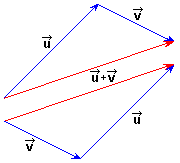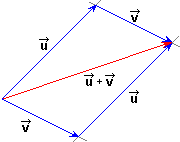|
ACTIVITY 1.3 |
|||
|
This construction states that the vector addition is commutative: This commutative property allows to make the vector addition using the called
|
|
|
INTERACTIVE ACTIVITY You have two vectors Move the points A and B, and notice the behaviour of the addition of two vectors. |
|
| HOMEWORK |
| We give to you the same vectors in previous activity |
 |
(
|
END OF ACTIVITY 1.3 |
|||

